Introduction
Water scarcity has become a widespread concern due to water pollution issues and drought conditions in the United States (Bennett, Carpenter, and Caraco 2001; Svoboda 2015). Previous research has shown that well and potable (drinking) water are often used by homeowners for indoor and outdoor purposes (Vickers 2001). As a result, one way to develop meaningful programs that lead to water conservation is to understand how consumers use water inside and outside their homes and create incentives for them to conserve water. Residential consumers account for most urban water use (Lee, Tansel, and Balbin 2011), with showers, toilets, and washing machines using the majority of indoor water (Mayer et al. 1999). Regarding outdoor water use, an estimated 75% of US residential water is used outdoors (Brehm, Pasko, and Eisenhauer 2013), with over half of it going to landscape irrigation (or roughly 9 billion gallons per day) (EPA 2016). Keeping this in mind, University of Florida researchers have assessed current household indoor and outdoor water use to identify US consumers' water use behavior. The purpose of this report is to summarize information related to indoor and outdoor water use and assist policy makers and researchers as they determine the best means for water conservation.

Methods
To analyze US household water use and irrigation practices, researchers developed an online survey and administered it to homeowners in California, Texas, and Florida in 2014. These three states were selected as study locations based on water scarcity issues (EPA 2008). Survey participation was limited to homeowners who had automated or traditional irrigation systems installed on their property. Survey questions included attitudinal questions about water availability, household water use, water conservation measures (e.g., water-efficient appliances), incentives to reduce water consumption, and willingness to pay for water-conserving items. Additional questions addressed outdoor water use and household irrigation practices.
Results
A total of 3,000 people participated (1,000 from each state) in the study. Of the participants, the majority were females under the age of 55 years old residing in an urban/suburban areas. The majority (76%) of respondents' households consisted of less than two adults and had no children under the age of 18 years old living at home. Most (70%) respondents' household income was less than $100,000, 58% were employed, and 33% had obtained a four-year college degree. Compared to US census data, the sample had a higher percentage of females and older population (US Census Bureau 2015).
Water Availability and Use
When asked how much they agreed with water supply statements related to their existing attitudes and awareness, the majority of respondents indicated that they were most concerned about the appearance of their yards, meaning that irrigation was important to maintain the aesthetics of their landscapes and that they and their neighbors overirrigated despite the need for water conservation in their state (Figure 1) (Kiesling and Manning 2010). Many respondents also indicated that they were aware of water restrictions in their area and that their water conservation efforts affected the overall water supply.
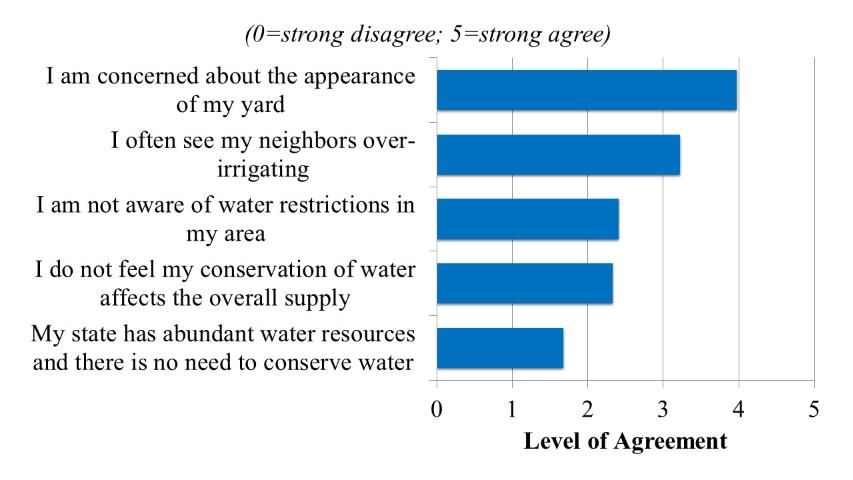
Credit: UF/IFAS
Regarding household water usage, many respondents took showers instead of baths and irrigated their landscapes during the coolest part of the day to reduce water loss due to evaporation (Figure 2). For outdoor water use, most respondents did not collect or recycle rainwater to help with landscape irrigation (Figure 3). Besides irrigation, outdoor water use included swimming pools (25%), fountains (13%), and hot tubs (12%). The high percentage of pool ownership reflects the warm climates of the surveyed areas. Cumulatively, the water supply and usage results indicate that California, Texas, and Florida homeowners are conscious of water issues in their areas and some modify their water-use behavior to conserve water.
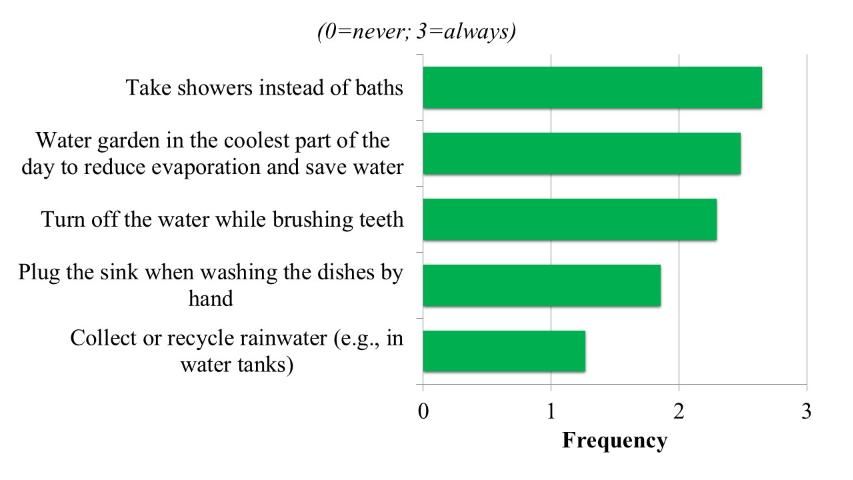

Credit: UF/IFAS
Water Conservation Measures
For purchasing home appliances (washing machines, dishwashers), 65% of respondents considered water efficiency (Figure 4). When asked about their water-efficient purchases in the past 10 years, rainwater collection tanks were the least frequently purchased item, with 77% of respondents not having purchased one. Regarding new purchases (within the last 10 years) of indoor water-conserving items (meaning they had been installed within the last 10 years), 42% of participants had purchased water-flow-restrictor taps/low-water shower heads, and 38% had purchased low-volume/dual-flush toilets while 41% had not. Regarding existing indoor water-conserving items (meaning they were already in the home when purchased or had been installed more than 10 years ago), low-volume/dual-flush toilets were the most common (19%), followed by the flow-restrictor taps/low-water shower heads (16%).
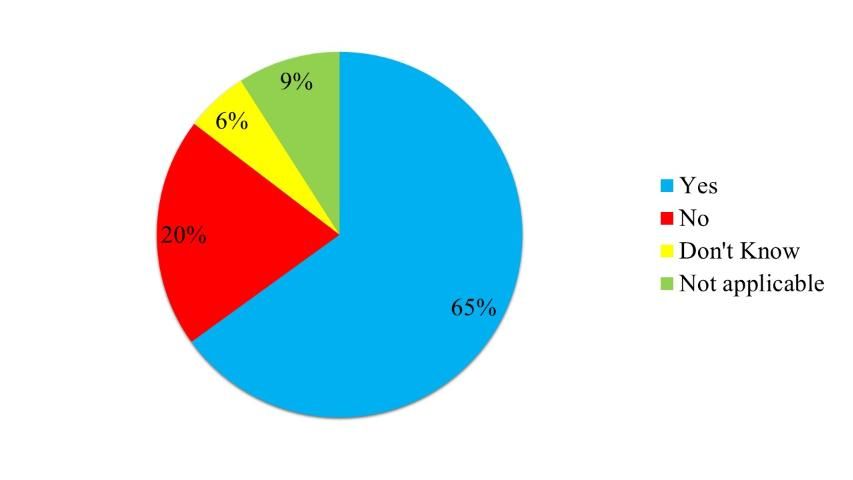
Credit: UF/IFAS
One means of altering consumer behavior is to offer consumers incentives to make changes. Here, researchers addressed governmental and nongovernmental incentives that may contribute to consumers' purchase and installation of water-conserving items. Governmental or utility company incentives to purchase these items were fairly scarce, the percentage of consumers receiving an incentive to install low-volume/dual-flush toilets was 18%; rainwater collection tanks, 17%; and flow-restrictor taps/low-water shower heads, 16% (Figure 5). Respondents also indicated how effective various incentives would be in changing their behavior and purchasing decisions. On average, respondents were very open to incentives that would lead to reduced water usage (Figure 6). Reducing the price of water-efficient equipment was perceived as the most effective strategy, followed by more practical information on household water conservation, easier identification of water-efficient appliances, landscape irrigation ordinances, higher water rates, and comparisons of household water usage. Additionally, having a real-time water use mobile app, more information on the environmental impacts of water conservation, and landscape ordinances limiting turfgrass would reduce water consumption.

Credit: UF/IFAS

Credit: UF/IFAS
Water Quality Valuation
Respondents were asked to indicate how much they would pay relative to their current water bill for better water quality. Most respondents (64%) value water quality and are willing to pay a premium to improve it (Figure 7). Regarding the amount respondents were willing to pay for better water quality, 26% were willing to pay less than 5%, 30% were willing to pay 5%–15% more, and 8% were willing to pay more than 15%. Overall, results indicate that the cost to improve tap water quality should not exceed 15% of homeowners' existing water bills.
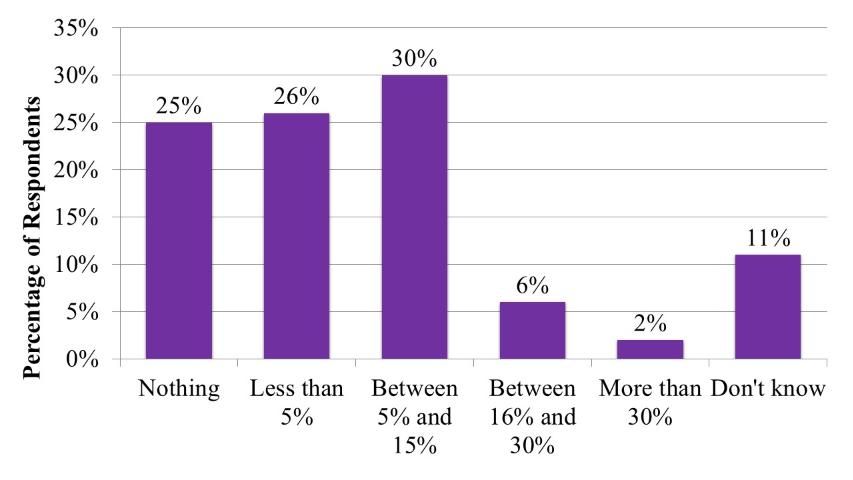
Credit: UF/IFAS
Lawn and Garden Irrigation
Landscape irrigation is the primary water use outside the home for households. Researchers assessed respondents' irrigation use by asking about the water source, irrigation frequency, percentage of turfgrass, and number of irrigation zones. Respondents indicated that most of their irrigation water comes from municipal/city/county water sources (69%), followed by well/surface water (14%), reclaimed water (9%), unsure about source (6%), and rain barrels (2%) (Figure 8). Most respondents indicated that they use their irrigation systems seasonally, mainly in the spring and summer (Figure 9). This result is consistent with growing seasons, where water needs are related to temperature, light intensity, and plant growth (Kiesling and Manning 2010).
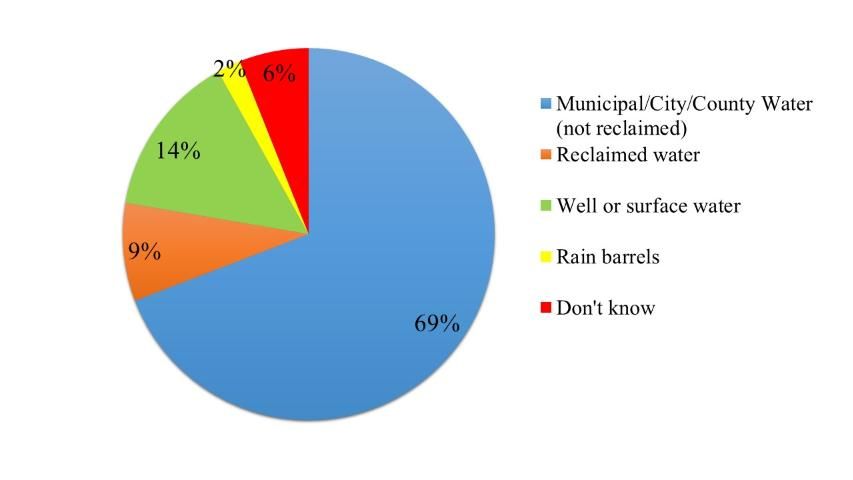
Credit: UF/IFAS

Credit: UF/IFAS
Irrigation requirements often vary based on planting density and plant type. Due to increased land area, turfgrass typically requires more irrigation than landscapes consisting primarily of ornamental plants. Respondents were asked to indicate the percentage of their property covered with turfgrass. In descending order, turfgrass coverage was 26%–50%, 51%–75%, 0%–25%, and more than 75% (Figure 10).
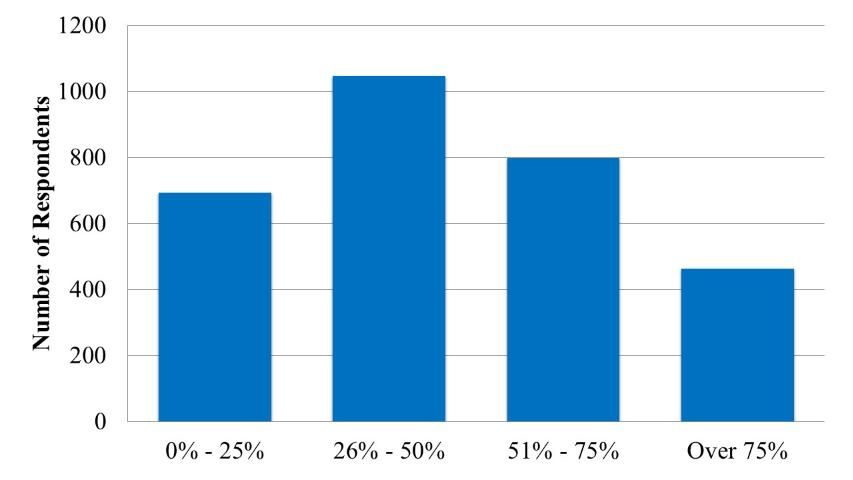
Often, irrigation system size can be determined by the number of zones. Irrigation zones are used to minimize water waste and maximize irrigation efficiency by matching sprinkler types and plants with similar water needs within each zone. Each zone typically has its own control valve. Forty-two percent of respondents' irrigation systems consisted of 5–8 zones, followed by 0–4 zones (38%), unsure of answer (11%), and greater than 9 zones (9%). The majority (66%) of respondents' systems were equipped with rain shut-off sensors.
Regarding irrigation system maintenance, 43% of respondents maintained their own irrigation system, 25% hired a landscape professional, 17% hired an irrigation specialist, 10% were maintained by other (e.g., HOA, property manager), and 5% hired no one (Figure 11). Regarding respondents' knowledge about irrigation systems and their yard characteristics, the majority of respondents were knowledgeable about local irrigation regulations and their irrigation zones (Figure 12). Many respondents were marginally knowledgeable about turf/plant water needs, turf/plant types, and sprinkler head types. They were less knowledgeable about the efficiency of their irrigation systems, soil type, and sprinkler application rates.
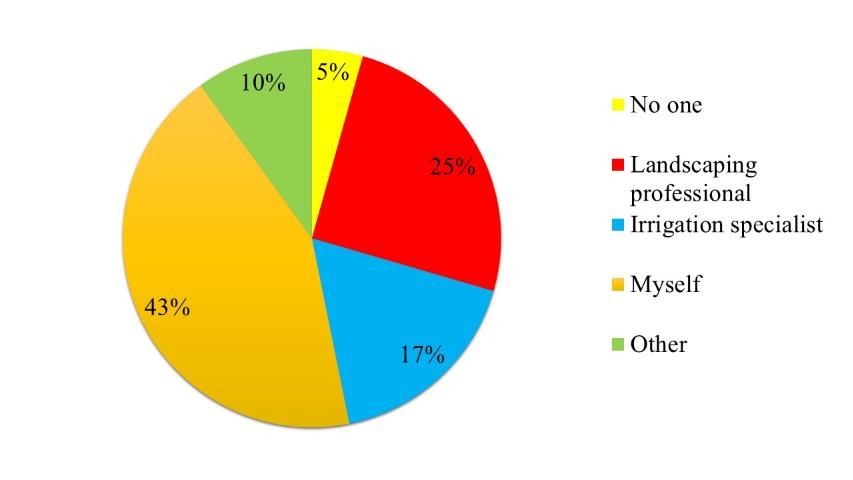
Credit: UF/IFAS
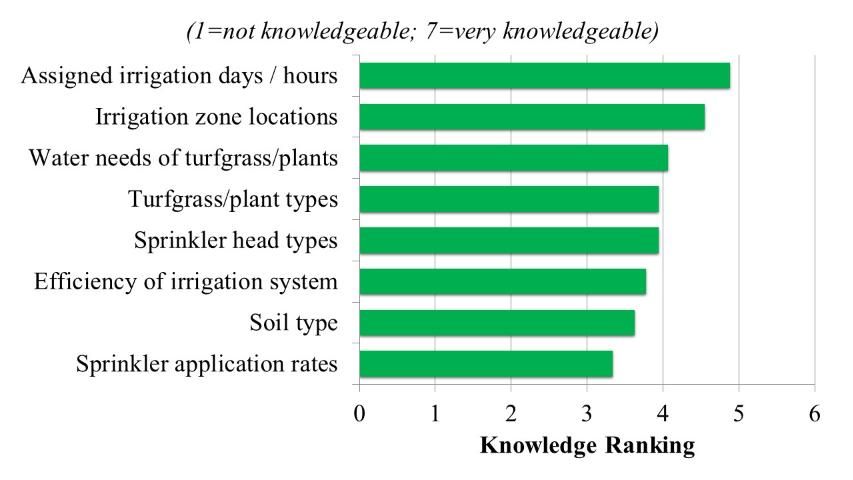
Credit: UF/IFAS
Summary
Homeowners in California, Texas, and Florida are aware of water issues in their areas. Many actions can be taken to improve household water conservation, including financial incentives to reduce the cost of water-efficient equipment, and landscape ordinances to limit irrigation or turfgrass areas. Additionally, many consumers would be willing to pay up to 15% of their current water bill for better-quality water. Overall, consumers would benefit from information about financial incentives to purchase water-efficient items. Results indicate that water efficiency influences homeowners' purchasing decisions, which suggests that clearly labeling and advertising water-efficient appliances, toilets, and tap/shower heads would be beneficial for water conservation.
Although homeowners take actions to conserve water within their households, the aesthetic appearance of their yards is still very important. Consequently, irrigation companies should offer irrigation systems that are effective and efficient to reduce residential water use. Most irrigation systems draw from municipal/city/county water sources and are used most frequently during the growing seasons (i.e., spring and summer). Results show a clear underutilization of rainwater tanks, although there is the potential to provide homeowners incentives for purchasing and using them in their irrigation systems to conserve water. Many homeowners are do-it-yourselfers (DIYers), so irrigation systems should be designed for easy homeowner maintenance and adjustment to assure proper irrigation techniques and to minimize nutrient runoff and over-irrigation. In addition, apps could be developed to track irrigation frequency and water usage or send reminders about when system maintenance is required.
In summary, respondents were aware of water issues in their areas and the need to minimize household water usage. More must be done to provide consumers with the necessary tools to conserve water (i.e., water-efficient products, financial incentives, etc.).
References
Brehm, J. M., D. K. Pasko, and B. W. Eisenhauer. 2013. "Identifying key factors in homeowner's adoption of water quality best management practices." Environmental Management 52(1):113–122.
Bennett, E. M., S. R. Carpenter, and N. F. Caraco. 2001. Human impact on erodible phosphorus and eutrophication: A global perspective. Increasing accumulation of phosphorus in soil threatens rivers, lakes, and coastal oceans with eutrophication. BioScience 51(3):227–234.
EPA. 2016. WaterSense. Washington, DC: EPA. https://www.epa.gov/watersense/outdoors
Kiesling F. M., and C. M. Manning. 2010. "How green is your thumb? Environmental gardening identity and ecological gardening practices." Journal of Environmental Psychology 30:315–327.
Lee, M., B. Tansel, and M. Balbin. 2011. "Influence of residential water use efficiency measures on household water demand: A four year longitudinal study." Resources, Conservation, and Recycling 56(1):1–6.
Mayer, P. W., W. B. DeOreo, E. M. Opitz, J. C. Kiefer, W. Y. Davis, B. Dziegielewski, and J. O. Nelson. 1999. Residential End Uses of Water. Denver, CO: American Water Works.
Svoboda, M. D. 2015. "The U.S. Drought Monitor: Evolution and recent achievements." In Drought: Research and Science-Policy Interfacing. London: Taylor & Francis Group.
U.S. Census Bureau. 2015. National Characteristics: Vintage 2014. Washington D.C: U.S. Census Bureau.
Vickers, A. 2001. Handbook of Water Use and Conservation: Homes, Landscapes, Businesses, Industries, Farms. Amherst, MA: WaterPlow Press.